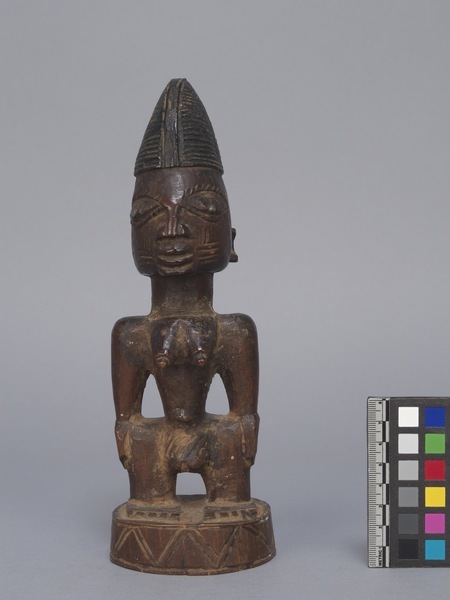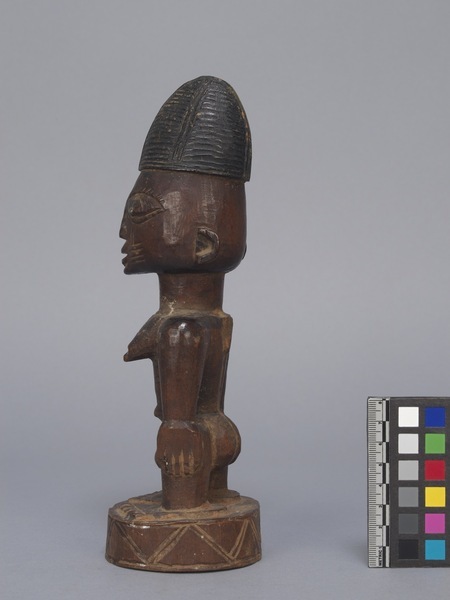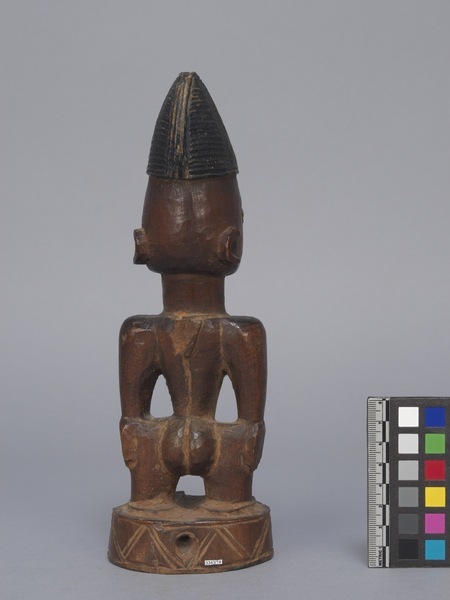Figure Item Number: 3343/14 from the MOA: University of British Columbia




Description
Standing wood figure, (ibeji) with headdress, on circular base. Nude female stands upright with arms connected to waist. Flat stomach below pointed breasts. Has pronounced belly button, buttocks and genitalia. Above genitalia diagonal lines are carved. Triangle carved in high relief on back, beneath neck. Eyes have thick lashes and a nail in their centre. Three vertical lines carved underneath each eye. Four horizontal lines carved next to open mouth. Ears flat against head. Tall cone-shaped headdress circled with horizontal lines and split into four sections with vertical bands. Circular pedestal has an alternating triangle pattern carved along sides. Hole drilled into back of pedestal.
History Of Use
Based on the sacred duality of "twoness" (èjìwàpò) found in nature, such as life/death, right/left, male/female, twins are understood as bringers of wealth and blessings to their family if they are satisfied, or misfortune if they are dissatisfied. As a result, living twins are treated with a high degree of respect and favouritism. When a twin, or both, dies the parents consult a diviner (babalawo), who communicates the desires of the deceased; small commemorative wooden figures (ère ìbejì) are carved to honour and represent them. Yorubas believe that twins share a soul, so the family was to treat the figure as they would if the twin was still physically present. As a result, the twin was fed, washed and cared for. Rather than realistic representations, ère ìbejì are idealized forms. They are often decorated with cowrie shells, beaded or metal bracelets, necklaces, and anklets, and cosmetics, such as osun (camwood powder), indigo, and efun (white chalk). By the mid-19th century, Christianity and Islam began to influence the design of ère ìbejì. Yoruba Muslims sometimes commissioned ere ibeji with carved torah, or leather packets containing quotations from the Quran, while Yoruba Christians incorporated Virgin Mary medals or crucifixes. In the mid-20th century, manufactured or plastic dolls began to replace the traditional ère ìbejì. Today, these dolls, in addition to the use of photographs, continue to sustain the ère ìbejì tradition.
Iconographic Meaning
The facial scarification on both cheeks (ila, or “lineage face mark”) indicates a specific community to which the represented deceased twin belongs.
Item History
- Made in Nigeria
- Collected in Ibadan, Nigeria during 1973
- Owned by Millie Morton before January 29, 2019
- Received from Millie Morton (Donor) on January 29, 2019
What
Who
- Culture
- Yoruba
- Previous Owner
- Millie Morton
- Received from
- Millie Morton (Donor)
Where
- Holding Institution
- MOA: University of British Columbia
- Made in
- Nigeria
- Collected in
- Ibadan, Nigeria
When
- Collection Date
- during 1973
- Ownership Date
- before January 29, 2019
- Acquisition Date
- on January 29, 2019
Other
- Item Classes
- carvings & sculpture
- Condition
- good
- Accession Number
- 3343/0014